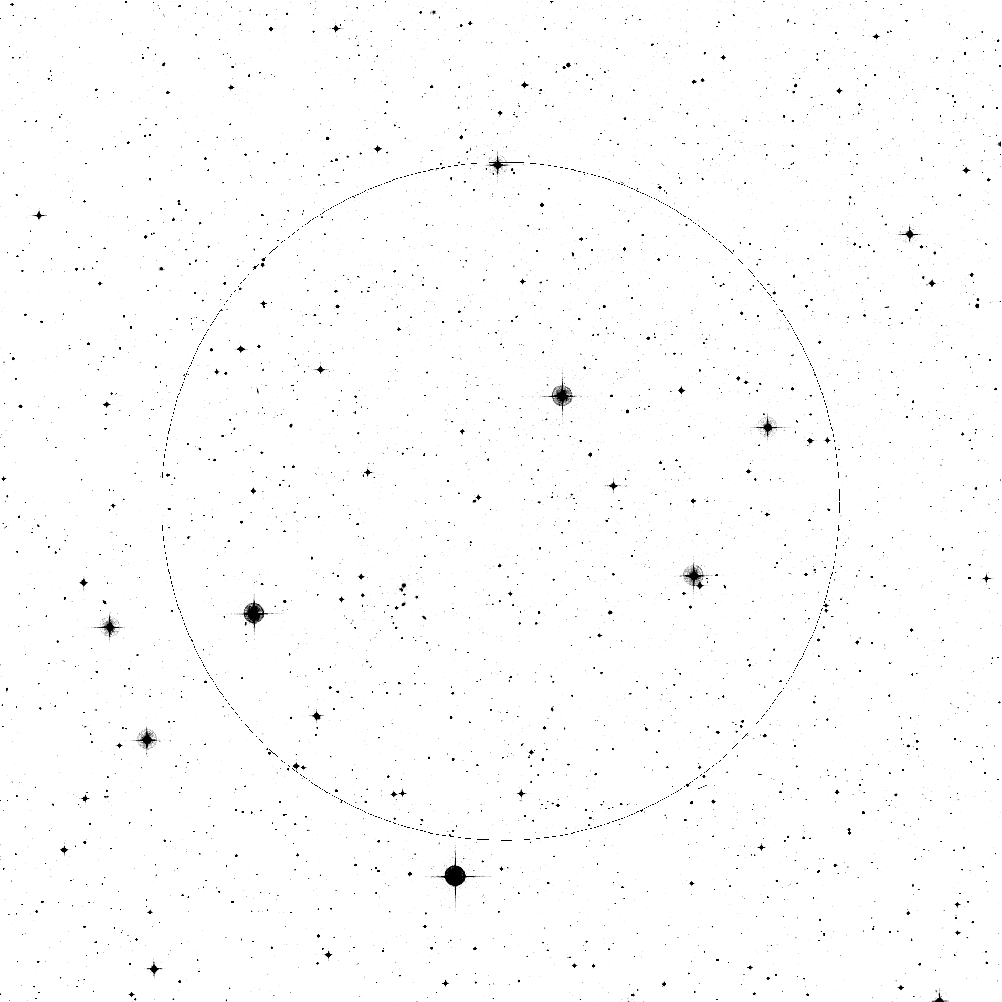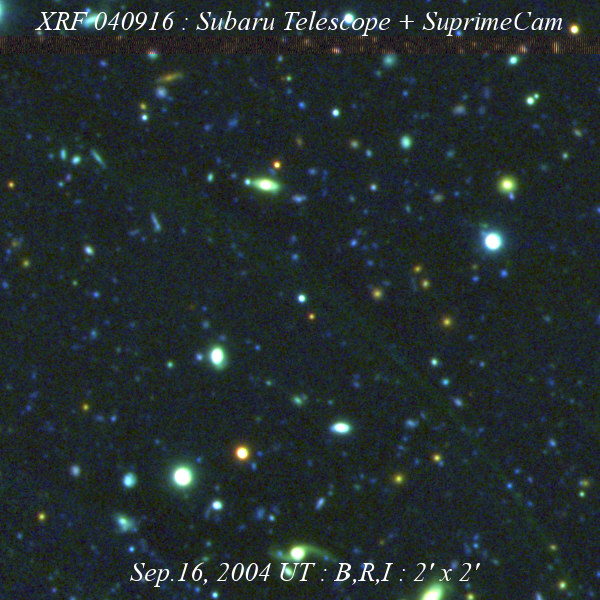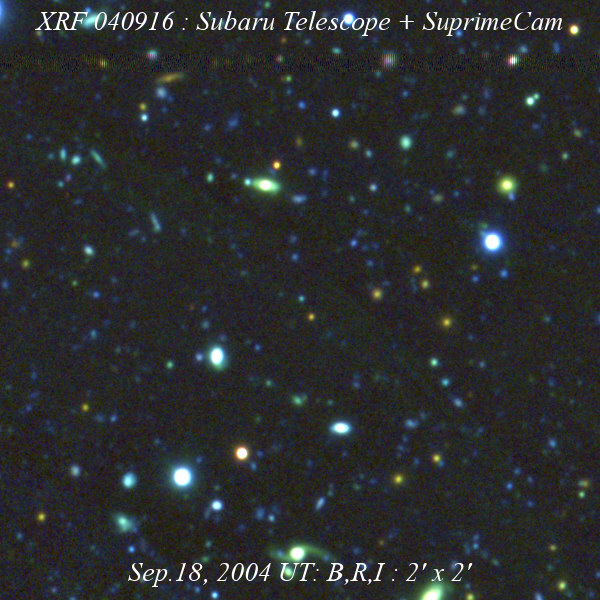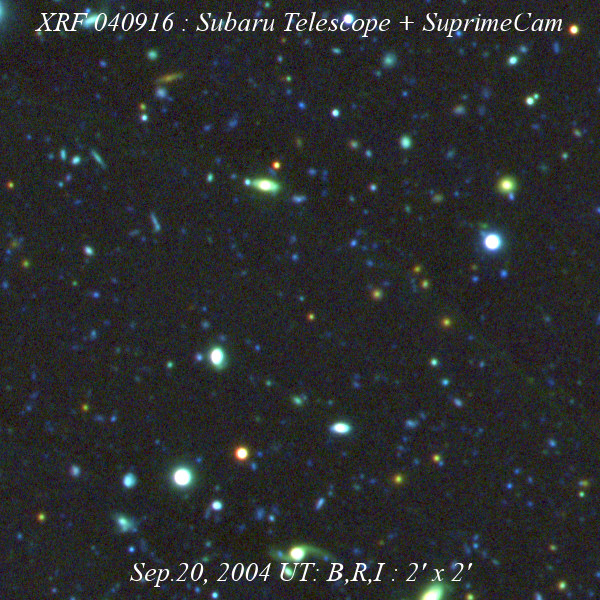- GCN/BACODINE POSITION NOTICE
TITLE: GCN/HETE BURST POSITION NOTICE
NOTICE_DATE: Thu 16 Sep 04 02:26:16 UT
NOTICE_TYPE: HETE Ground Analysis
TRIGGER_NUM: 3558, Seq_Num: 1
GRB_DATE: 13264 TJD; 260 DOY; 04/09/16
GRB_TIME: 209.70 SOD {00:03:29.70} UT
TRIGGER_SOURCE: Trigger on the 2-30 keV band.
SC_-Z_RA: 175 [deg]
SC_-Z_DEC: 1 [deg]
SC_LONG: 14 [deg East]
WXM_CNTR_RA: 345.434d {+23h 01m 44s} (J2000),
345.495d {+23h 01m 59s} (current),
344.786d {+22h 59m 09s} (1950)
WXM_CNTR_DEC: -5.629d {-05d 37' 43"} (J2000),
-5.604d {-05d 36' 12"} (current),
-5.898d {-05d 53' 52"} (1950)
WXM_MAX_SIZE: 36.60 [arcmin] diameter
WXM_LOC_SN: 12 sig/noise (pt src in image)
WXM_IMAGE_SN: X= 4.9 Y= 3.9 [sig/noise]
WXM_LC_SN: X= 10.5 Y= 6.1 [sig/noise]
SUN_POSTN: 174.00d {+11h 36m 01s} +2.59d {+02d 35' 33"}
SUN_DIST: 171.00 [deg]
MOON_POSTN: 190.61d {+12h 42m 26s} -2.36d {-02d 21' 30"}
MOON_DIST: 153.68 [deg]
MOON_ILLUM: 2 [%]
GAL_COORDS: 67.47,-56.19 [deg] galactic lon,lat of the burst
ECL_COORDS: 344.42,0.55 [deg] ecliptic lon,lat of the burst
COMMENTS: Definite GRB.
COMMENTS: WXM error box is circular; not rectangular.
COMMENTS: Burst_Validity flag is true.
COMMENTS: WXM data refined since S/C_Last Notice.
- GCN notice #2712
GRB040916 (= H3558): A Long XRF Localized by HETE
T. Yamazaki, G. Ricker, J-L. Atteia, N. Kawai, D. Lamb, and S. Woosley,
on behalf of the HETE Science Team;
T. Donaghy, E. Fenimore, M. Galassi, C. Graziani, M. Matsuoka,
Y. Nakagawa, T. Sakamoto, R. Sato, Y. Shirasaki, M. Suzuki,
T. Tamagawa, Y. Urata, Y. Yamamoto, and A. Yoshida, on behalf of the
HETE WXM Team;
N. Butler, G. Crew, J. Doty, A. Dullighan, G. Prigozhin, R. Vanderspek,
J. Villasenor, J. G. Jernigan, A. Levine, G. Azzibrouck, J. Braga,
R. Manchanda, and G. Pizzichini, on behalf of the HETE Operations and
HETE Optical-SXC Teams;
C. Barraud, M. Boer, J-F Olive, J-P Dezalay, and K. Hurley, on behalf
of the HETE FREGATE Team;
report:
At 00:03:30 UT (209 SOD) on 16 September 2004, the WXM instrument
on HETE detected GRB040916 (= H3558), a long, two-peaked XRF. The
burst has been localized to a circle of 18' radius centered on
RA = 23h 01m 44s, Dec = -5d 37' 43" (J2000)
The burst consists of two peaks separated by ~250s, each ~100s in
duration. No formal spectral analysis has been performed using WXM
data, but the dearth of counts in bands > 10 keV in either peak is a
strong indication that GRB040916 is an XRF.
We anticipate providing additional spectral information from this
unusual event in a subsequent GCN Circular.
This message may be cited.
- GCN/BACODINE POSITION NOTICE
TITLE: GCN/HETE BURST POSITION NOTICE
NOTICE_DATE: Thu 16 Sep 04 03:58:41 UT
NOTICE_TYPE: HETE Ground Analysis
TRIGGER_NUM: 3558, Seq_Num: 2
GRB_DATE: 13264 TJD; 260 DOY; 04/09/16
GRB_TIME: 209.70 SOD {00:03:29.70} UT
TRIGGER_SOURCE: Trigger on the 2-30 keV band.
SC_-Z_RA: 175 [deg]
SC_-Z_DEC: 1 [deg]
SC_LONG: 14 [deg East]
WXM_CNTR_RA: 345.376d {+23h 01m 30s} (J2000),
345.437d {+23h 01m 45s} (current),
344.728d {+22h 58m 55s} (1950)
WXM_CNTR_DEC: -5.583d {-05d 35' 00"} (J2000),
-5.558d {-05d 33' 28"} (current),
-5.852d {-05d 51' 08"} (1950)
WXM_CORNER1: 345.5070 -5.8360 [deg]
WXM_CORNER2: 345.0990 -5.6310 [deg]
WXM_CORNER3: 345.2450 -5.3310 [deg]
WXM_CORNER4: 345.6530 -5.5359 [deg]
WXM_MAX_SIZE: 34.10 [arcmin] diameter
WXM_LOC_SN: 12 sig/noise (pt src in image)
WXM_IMAGE_SN: X= 7.8 Y= 4.2 [sig/noise]
WXM_LC_SN: X= 11.1 Y= 3.2 [sig/noise]
SUN_POSTN: 174.00d {+11h 36m 01s} +2.59d {+02d 35' 33"}
SUN_DIST: 170.96 [deg]
MOON_POSTN: 190.61d {+12h 42m 26s} -2.36d {-02d 21' 30"}
MOON_DIST: 153.64 [deg]
MOON_ILLUM: 2 [%]
GAL_COORDS: 67.46,-56.12 [deg] galactic lon,lat of the burst
ECL_COORDS: 344.38,0.61 [deg] ecliptic lon,lat of the burst
COMMENTS: Definite GRB.
COMMENTS: Burst_Validity flag is true.
COMMENTS: WXM data refined since S/C_Last Notice.
- GCN notice #2713
GRB040916 (= H3558): Improved Localization from HETE WXM
Y. Yamamoto, G. Ricker, J-L. Atteia, N. Kawai, D. Lamb, and S.
Woosley, on behalf of the HETE Science Team;
T. Donaghy, E. Fenimore, M. Galassi, C. Graziani, M. Matsuoka, Y.
Nakagawa, T. Sakamoto, R. Sato, Y. Shirasaki, M. Suzuki, T. Tamagawa,
Y. Urata, T. Yamazaki, and A. Yoshida, on behalf of the HETE WXM Team;
N. Butler, G. Crew, J. Doty, A. Dullighan, G. Prigozhin, R.
Vanderspek, J. Villasenor, J. G. Jernigan, A. Levine, G. Azzibrouck,
J. Braga, R. Manchanda, and G. Pizzichini, on behalf of the HETE
Operations and HETE Optical-SXC Teams;
C. Barraud, M. Boer, J-F Olive, J-P Dezalay, and K. Hurley, on behalf
of the HETE FREGATE Team;
report:
By utilizing the WXM data from both peaks of GRB040916 (= H3558;
Yamazaki et al, GCN2712), the localization of this unusual XRF has
been refined to an 90% confidence error box with corners at the
following coordinates (J2000):
RA = 23 02 01.68, Dec = -05 50 09.6
RA = 23 00 23.76, Dec = -05 37 51.6
RA = 23 00 58.80, Dec = -05 19 51.6
RA = 23 02 36.72, Dec = -05 32 09.6
The area of the error box is 545 square arc minutes.
This message may be cited.
- red DSS finding chart (17.05 arcmin radius)
ps-file

- GCN notice #2714
Rykoff, E. S., Quimby, R. & Schaefer, B. E. Report on behalf of the
ROTSE Collaboration:
ROTSE-IIIb at McDonald Observatory, Texas, responded automatically to
the HETE Ground alert #3558. The first exposure began at 02:29:48.2
(UTC), approximately 2.4 hours after the burst time reported by Yamazaki
et al. (GCN Circ. 2712, 2713). The ROTSE-IIIb system automatically
scheduled a series of 10 20-s images followed by a long series of 60-s
images. As of this writing, we have analyzed 40 images. We have also
co-added sets of 10 images. Our unfiltered limiting magnitudes are
around 18.3 for the single exposures, and 19.2 for the co-added frames.
Visual comparison of the co-added frames to the DSS reveals 3 new
objects in the HETE-2 error circle reported in GCN Circ. 2712. These
three sources are identified as asteroids by their proper motion, and
are in the MpChecker database (Ruanda, 1997 WZ36, and 2004 PN39). At
this time, we have no candidate counterparts to the GRB.
- GCN notice #2715
P. Kilmartin & A. Gilmore (Mt. John Observatory of University of
Canterbury) reports on behalf of the AAVSO International High Energy
network:
Two sets of frames centered on the coordinates for GRB040916 (Yamamoto et
al., GCN 2712; HETE trigger 3558) show a stationary object not visible on
DSS2 R and IR images, at:
RA = 23 01 44.01 Dec = -05 39 11.3 (2000.0)
Unfiltered R magnitudes at mean times
08:29 UT 19.7 S/N = 2.8
09:54 UT 19.9 S/N = 3.3
Observations were made under clear conditions with the 0.6 meter
cassegrain telescope with f/6.4 focal reducer on Mt. John. Seeing was
approximate 3 arcsec and limiting magnitude roughly 20.5 in R. The USNO
A2.0 catalog in Astrometrica was used for photometry and astrometry
reduction. CCD field of view was 9x9 arc minutes.
More information on the exposure and the FITS image itself is available
at:
ftp://ftp.aavso.org/grb/
Note, there are many red sources in the field and these observations are
unfiltered so there is a strong possibility that this OT candidate is just
a faint red source.
The AAVSO International High Energy network is greatful for a generous
grant from the Curry Foundation and to NASA for the financial support for
the High Energy Workshops for Amateur Astronomers and to the SWIFT E/PO
program for continued funding.
- GCN notice #2717
A. de Ugarte Postigo, D. Reverte-Pay=E1, J. Gorosabel,
S. Guziy, M. Jel=EDnek, J. V=EDlchez and A. J. Castro-Tirado
(IAA-CSIC, Granada),
report:
We have taken R-band frames covering the error box
for the long-lasting XRF 040916 detected by HETE-2
(Yamazaki et al., GCN Circ. 2712; Yamamoto et al.
GCN Circ. 2713). A set of five images (300-s exposure
time each) was taken at the 2.5m INT (+WFC) on
La Palma during the time interval 16 Sep (02:50 UT -
04:06 UT, i.e. 2.87-4.05 hr after the burst). No new or
strongly variable object is found in the entire error box
down to R =3D 21, when comparing with the DSS-2 red.
This message can be quoted.
- GCN notice #2718
Michael J.I. Brown (Princeton) and Nigel C. Hambly (ROE) report:
We have queried the SuperCOSMOS Sky Survey
(http://www-wfau.roe.ac.uk/sss/)
for previous optical detections of the GRB040916 optical afterglow
candidate reported by Kilmartin & Gilmore (GCN 2715). This object has been
previously detected in a Bj photographic plate from 1982 taken with the UK
Schmidt Telescope at the Anglo Australian Observatory (UKST plate J8169).
This object is not detected in SuperCOSMOS scans of R or I-band plates
(UKST plates OR14538 and I15787). UK Schmidt photographic survey plates
typically have limiting magnitudes of Bj~22.5, R~21.5 and I~19.5.
The coordinates and magnitude of this object are
RA = 23:01:43.975, Dec = -05:39:12.02 (J2000.0), and Bj = 20.9 +/- 0.2.
These coordinates are 1 arcsecond from the position reported by
Kilmartin & Gilmore (GCN 2715).
We note that this object has a compact morphology and it is therefore
plausible that this is a star or AGN rather than a GRB afterglow or GRB
host galaxy.
This message may be cited.
- GCN notice #2719
A. Henden (USRA/USNO) reports on behalf of the USNO GRB team:
We have acquired BVRcIc all-sky photometry for
a 11x11 arcmin field centered on the HETE coordinates
(trigger 3558; Yamazaki et al. GCN 2712, Yamamoto et al. GCN 2713)
for GRB/XRF040916 with the USNOFS 1.0-m telescope on one photometric
night. Stars brighter than V=13.5 are saturated and
should be used with care. We have placed the photometric data
on our anonymous ftp site:
ftp://ftp.nofs.navy.mil/pub/outgoing/aah/grb/xrf040916.dat
The astrometry in this file is based on linear plate solutions
with respect to UCAC2. The external errors are less than 100mas.
The estimated external photometric error is about 0.03mag
and will be improved with additional calibration nights
if an afterglow is discovered.
As always, you should check the dates on the .dat file prior to
final publication to get the latest photometry. There is
a README file on the ftp directory to give you information
about the procedures used to calibrate these fields.
- GCN notice #2721
XRF040916: optical follow-up observations
W.L. Wu, K.Y. Huang, W.H. Ip (NCU)
Y. Urata, T. Tamagawa (RIKEN) report :
"We have observed the optical candidate reported by Kilmaritin et
al. (GCN 2715) with 1.0m telescope at Lulin Observatory (National
Central University, Taiwan). We obtain I-band images with 600 sec
exposure on 2004 16 Sep. 16.68 UT (16.3 hr after burst) and 17
Sep. 12.51 UT (1.5 day after burst). We can not find any variablity for
the source. The brithness of the source are
OT candidate seeing
16 Sep. 16.68 UT I = 19.6 2.0 arcsec
17 Sep. 12.51 UT I = 19.7 2.5 arcsec
The limiting magnitude is around 20.1 which comparison with USNO A.2
red magnitude."
This message may be cited
- GCN notice #2722
A. Henden (USRA/USNO) reports on behalf of the USNO GRB team:
We have compared our 3 epochs of Ic imaging using the
NOFS 1.0m telescope for the candidate mentioned by Kilmartin
and Gilmore (GCN 2715). In a similar manner to Wu et al. (GCN 2721),
we find no variability within photometric errors:
UTD Ic err
040916.1869 20.08 0.17
040916.2699 19.83 0.14
040917.2932 19.89 0.09
This photometry is calibrated using the data from
Henden (GCN 2719).
- GCN notice #2725
M.Cwiok, K.Kwiecinska, L.Mankiewicz, K.Nawrocki,
B.Pilecki, L.W.Piotrowski, G.Pojmanski, R.Salanski,
M.Sokolowski, D.Szczygiel, G.Wrochna,
on behalf of "Pi of the Sky / ASAS" collaboration
http://grb.fuw.edu.pl
The central part of HETE FOV containing GRB040916 error box
was observed by "Pi of the Sky" apparatus at Las Campanas
Observatory for the night of 2004.09.15/16
from 00:20:54 UT (17 min after the GRB) till 09:05:00 UT.
10s exposures were taken continuously with 4s intervals
by two CCD cameras.
No unknown objects wrt Tycho-2 and GSC catalogues
has been observed within the GRB040916 error box.
The limiting magnitude is ~11.5m for single frames
and ~13.0m for 20 coadded frames. More information at
http://grb.fuw.edu.pl/pi/ot/grb040916/
- GCN notice #2726
G. Kosugi, N. Kawai, A. Tajitsu, and H. Furusawa
on behalf of the Subaru GRB Team:
We have obtained Rc, Ic, and B-band images covering the entire
error box for XRF040916 (=H4588, Yamazaki et al., GCN 2712;
Yamamoto et al. GCN 2713) with SuprimeCam attached on the
prime-focus of the Subaru 8.2m telescope atop Mauna Kea. We
conducted a preliminary analysis and found a fading object
located at coordinates:
RA: 23:00:55.1 Dec: -05:38:43 J2000
The object was seen to fade in either of Rc, Ic, and B bands.
Observing dates and tentative Rc-band magnitudes of OT are
shown below. Photometric accuracy is roughly +/- 0.2 mag.
Date Magnitude(Rc-band)
Sep.16, 5.6UT 22.3
Sep.16, 8.8UT 22.7
Sep.18, 11.8UT 24.8
This message may be cited.
- GCN notice #2727
A. Henden (USRA/USNO) reports on behalf of the USNO GRB team:
We have an Ic mosaic of the field for XRF040916
(Yamazaki et al. GCN 2712) taken with the NOFS 1.0m telescope
about an hour earlier than the data reported by
Kosugi et al. (GCN 2726). Their proposed candidate appears
on that mosaic at position
23:00:55.13 -05:38:43.2 J2000
(errors 0.2arcsec) and with magnitude
Ic = 20.51 +/- 0.23
based on the calibration photometry of Henden (GCN 2719).
This would imply a very red object or rapid fading.
- GCN notice #2729
TAROT Observations of GRB 040916 (HETE #3558)
Klotz, A., Atteia, J.L., G. Stratta, and Boer M. report:
TAROT observed the HETE Ground alert #3558
from 2004 Sept. 16 02:26:59 UT
to 2004 Sept. 16 02:57:35 UT,
as a series of 30-s unfiltered images
in the field described by Yamazaki et al.
(GCN Circ. 2712, 2713).
We first computed the medians of sub-series
of 3 images to eliminate cosmics, which were
then co added to obtain a single image.
Comparing to the USNO-1B catalog and DSS
image, we are able to detect all stars
brighter than R=19.4, and very few
stars fainter than R=20.0.
The candidate proposed Kosugi et al.
(GCN 2726) is not detected at the 3
sigma level. We conclude that the
afterglow had a magnitude R > 19.4
in a time period extending from 2.39 to 2.89 hours
after the GRB.
We note that a fuzzy patch is seen at
mag R=19.5 in the image at the position of
the afterglow, which we do not
consider as the afterglow, but as a background
fluctuation.
This message may be cited
- GCN notice #2730
G. Kosugi, N. Kawai, A. Tajitsu, and H. Furusawa
on behalf of the Subaru GRB Team:
We have observed the entire HETE error box for XRF040916 (=H3558,
Yamazaki et al., GCN 2712; Yamamoto et al. GCN 2713), with Subaru
Suprime Cam beginning at around 6:00 UT on September 20, 2004 in
z'-, Ic-, Rc-, V-, and B-bands. The observed field was centered
at the proposed OT candidate reported by Kosugi et al. GCN 2726.
The OT was clearly detected in all 5 bands, and shows apparent
decay of flux in Ic-, Rc-, and B-bands compared with our
previous observations on September 18. Rc-band magnitude of OT
at Septempber 20.43 UT was approximately Rc=25.
Composite color images are posted at:
http://www.naoj.org/staff/george/Distribute/XRF040916/XRF040916.html
OT is located at the center of the images.
Due to change of instruments, we cannot continue optical monitoring of
OT with Subaru for the next two weeks. Follow-up optical observation
of the OT is strongly encouraged for possible supernova rebrightening.
This message may be cited.



- GCN notice #2732
D. A. Frail (NRAO) and A. M. Soderberg (Caltech) report on behalf of a
larger collaboration:
"On 2004 Sept. 23.22 UT we carried out follow-up observations with the
VLA at 8.46 GHz centered on the optical afterglow candidate (GCN 2726)
of XRF 040916 (GCN 2712). Within a circle of 1-arcsec radius there are
no radio sources to a 3-sigma limit of 99 microJy.
No further observations are planned."
- GCN notice #2796
Christine Lamanna, Matt Bayliss, Ron Canterna, Dan Reichart, Arne Henden,
Don Lamb, and Melissa Nysewander report on behalf of the U. Wyoming, U.
North Carolina, USNO, and U. Chicago GRB teams of the FUN GRB
Collaboration:
We observed the afterglow location (Kosugi et al., GCN 2726) of XRF 040916
(Yamazaki et al., GCN 2712; Yamamoto et al., GCN 2713) in V with the
2.3-meter WIRO telescope beginning 4.78 hours (mean epoch = 4.86 hours) and
again 1.49 days after the burst. For our first epoch, we find that V =
22.12 +/- 0.06. For our second epoch, we find that V > 21.5 (2 sigma).
Using Subaru, Kosugi et al. (GCN 2726) find the afterglow to be R = 22.3
+/- 0.2 at 5.6 hours. Using USNO's 1.0-meter telescope, Henden (GCN 2727)
finds the afterglow to be Ic = 20.51 +/- 0.23 at 4.6 hours. As Henden
(2727) stated, this implies that the afterglow was very red or rapidly
fading at this time.
The WIRO and USNO observations are nearly simultaneous, and yield a
spectral index -2.8 +/- 0.6, which is very red.
If this is due to extinction, the observer-frame A_V is likely ~3 mag and R
- Ic ~ 0.6 mag and B - R ~ 1.4 mag. Consequently, at the epochs of the
first three Subaru observations (t = 5.6, 8.8, and 60 hours after the
burst) the afterglow would be I ~ 21.7, 22.1, and 24.2 and B ~ 23.7, 24.1,
and 26.2.
If this turns out not to be the case, the color of the afterglow likely
changed, perhaps very rapidly, between the USNO/WIRO observations and the
Subaru observations.
One possible explanation for this would be an early-time dust echo. Moran
& Reichart (astro-ph/0409390, posted two hours before the burst) predict
that light from the optical flash will scatter off of a circum-progenitor
dust shell, similar to the dust shells that are found around late-type WC
stars. This results in excess light on a timescale of minutes to hours
after the burst, and this excess light quickly transitions from blue to red
before fading away. For example, this ~1.6 mag difference between Ic and V
would not be difficult to explain with an optical flash of peak brightness
~12th mag and a dust shell of inner radius ~10^16 cm.
Finally, we note that GRB 980329 had a similar, unexplained two magnitude
difference between the I and R bands, in this case about 18 hours after the
burst (Reichart et al. 1999, ApJ, 517, 692).
Images and light curves will be posted at:
www.physics.unc.edu/~mbayliss/grb040916.html
- astro-ph/0703045 from 2 Mar 2007
Arimoto: HETE-2 Observations of the X-Ray Flash XRF 040916
A long X-ray flash was detected and localized by the instruments aboard the
High Energy Transient Explorer II (HETE-2) at 00:03:30 UT on 2004 September 16.
The position was reported to the GRB Coordinates Network (GCN) approximately 2
hours after the burst. This burst consists of two peaks separated by 200 s,
with durations of 110 s and 60 s. We have analyzed the energy spectra of the
1st and 2nd peaks observed with the Wide Field X-Ray Monitor (WXM) and the
French Gamma Telescope (FREGATE). We discuss the origin of the 2nd peak in
terms of flux variabilities and timescales. We find that it is most likely part
of the prompt emission, and is explained by the long-acting engine model. This
feature is similar to some bright X-ray flares detected in the early afterglow
phase of bursts observed by the Swift satellite.
![]() Previous IAU Circulars
Previous IAU Circulars 


